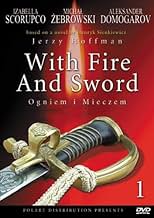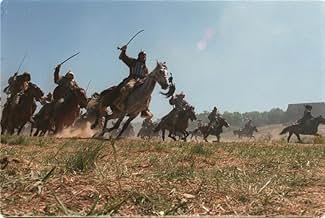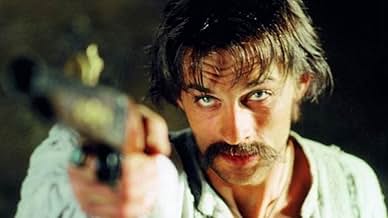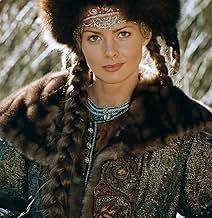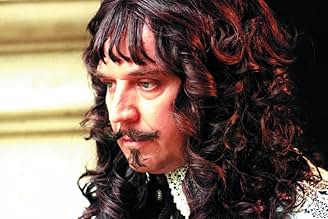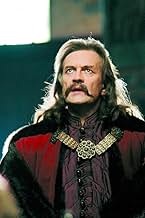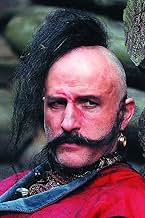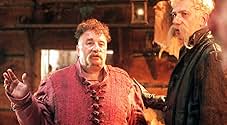Ogniem i mieczem
- 1999
- 2 घं 55 मि
IMDb रेटिंग
7.0/10
5.8 हज़ार
आपकी रेटिंग
अपनी भाषा में प्लॉट जोड़ेंAn epic story about the Ukrainian uprising against the Polish-Lithuanian Commonwealth magnates in the 17th Century.An epic story about the Ukrainian uprising against the Polish-Lithuanian Commonwealth magnates in the 17th Century.An epic story about the Ukrainian uprising against the Polish-Lithuanian Commonwealth magnates in the 17th Century.
- पुरस्कार
- 5 जीत और कुल 9 नामांकन
Jacek Rozenek
- Jurko Bohun
- (वॉइस)
Bogdan Stupka
- Bohdan Chmielnicki
- (as Bohdan S. Stupka)
Ruslana Pisanka
- Horpyna
- (as Ruslana Pysanka)
फ़ीचर्ड समीक्षाएं
Mostly for Polish viewers, some basic knowledge of 17th century Poland may be helpful if you want to understand the movie. It's about the rebellion of Ukrainian Cossacks against their lords - Polish nobility (it was before tsars conquered Ukraine). Polish prince Jeremi Wisniowiecki fights them with extreme atrocity but when they ally with Tatars, is forced to withdraw to the fortress of Zbaraz. These events form a background for the love between one of Polish commanders and girl he meets while carrying out some emissary mission for the prince. The movie is based on the novel "With Fire and Sword" (orig. "Ogniem i mieczem") by Henryk Sienkiewicz (Nobel award for "Quo Vadis"). This book is the first part of a trilogy, other parts have also been filmed. I think it's important to read the novel and see all mentioned movies - "The Deluge" (orig. "Potop") and "Pan Michael" (orig. "Pan Wolodyjowski").
As a movie based on a book that is a staple of Polish reading, it is bound to attract its adherents and detractors. But overall it has enough merit to it to warrant at least a single viewing.
The story is set in the 17th century, during a period of strife on the eastern fringes of Polish territory, in today's Ukraine. The main plot centers around a rebellion of Cossacks against the oppression of Polish landowners, in the greater setting of a conflict between Poland, Muscovy and the Tartars.The book was written from a Polish standpoint, so there is some obvious favoritism shown, but the main characters are not one dimensional. The motivations of the characters are clearly explained, and the good guy is not always good, and the bad guy is not always bad. The political intricacies may be a bit confusing, but at its heart this movie is a love triangle, so as long as you focus on that, you can follow along.
The main reason to watch this movie is visual. If you are one of those people who likes to have a movie transport them to another time and place, this movie is for you. The costumes, props and scenery are simply beautiful. All the characters speak in the language they are supposed to speak, so you have conversations in Polish, Ukranian and even Tartar. The performances by the main characters are wonderful, ranging from comedy to romance to drama to action.
The movie has a bit of something for everyone. If you like action, the battle sequences are fantastic, very massive in scale. If you like romance, the lead characters are not too hard on the eyes, and their passionate feelings come across the screen quite strongly. There is a very strong comedy element as well, but you might have to understand Polish to appreciate it fully.
The special effects in this movie leave a bit to be desired. It certainly is a bloody, and at times gory film, but really no worse than a lot of recent US offerings.
If I was to use a US movie as a thematic comparison, Last of the Mohicans might be a good choice, with the hero looking for his love in a wild and savage environment.
Overall I would recommend this movie to fans of historical films. The plot is fairly straightforward, so you can focus on watching the visuals instead.
The story is set in the 17th century, during a period of strife on the eastern fringes of Polish territory, in today's Ukraine. The main plot centers around a rebellion of Cossacks against the oppression of Polish landowners, in the greater setting of a conflict between Poland, Muscovy and the Tartars.The book was written from a Polish standpoint, so there is some obvious favoritism shown, but the main characters are not one dimensional. The motivations of the characters are clearly explained, and the good guy is not always good, and the bad guy is not always bad. The political intricacies may be a bit confusing, but at its heart this movie is a love triangle, so as long as you focus on that, you can follow along.
The main reason to watch this movie is visual. If you are one of those people who likes to have a movie transport them to another time and place, this movie is for you. The costumes, props and scenery are simply beautiful. All the characters speak in the language they are supposed to speak, so you have conversations in Polish, Ukranian and even Tartar. The performances by the main characters are wonderful, ranging from comedy to romance to drama to action.
The movie has a bit of something for everyone. If you like action, the battle sequences are fantastic, very massive in scale. If you like romance, the lead characters are not too hard on the eyes, and their passionate feelings come across the screen quite strongly. There is a very strong comedy element as well, but you might have to understand Polish to appreciate it fully.
The special effects in this movie leave a bit to be desired. It certainly is a bloody, and at times gory film, but really no worse than a lot of recent US offerings.
If I was to use a US movie as a thematic comparison, Last of the Mohicans might be a good choice, with the hero looking for his love in a wild and savage environment.
Overall I would recommend this movie to fans of historical films. The plot is fairly straightforward, so you can focus on watching the visuals instead.
It seems to me that all means of expression are guite justified in this movie. It forced me to read the whole source trilogy (Ogniem i mieczem, Potop, Pan Wolodyjowski) by Henryk Sienkiewicz. Characters are very humaly, realistic and true. Battles are very naturalistic.
Everyone in Poland have been waiting for this movie for a long, long time. Some of us even twenty years. But these ones who have watched other parts of the Trilogy now are not disappointed (maybe not everyone but the most). Jerzy Hoffman made a really great movie. I agree that not every actress(read: Izabella Skorupka-this is her Polish name) was good in her role but thanks God we wouldn't have to watch many scenes with her. Of course we can forgive this to mister Hoffman. Everyone can make a mistake. But if we look at this work of art from the other side we can see many fantastic Polish actors like: Daniel Olbrychski(who played in every part of the Trilogy), Michal Zebrowski, Krzysztof Kowalewski or Andrzej Seweryn. They are really great in their roles. They are vivid and credible. I have to say that I cried watching this movie. There were two scenes at which my handkerchief was wet. First: when they found Skrzetuski crying in the village and second it was almost the last scene: when Jan finds out that Helena is alive. But one there is one thing which I hate in Hoffman's movies: his no-limits cruelty (for example in the movie "Pan Michael" he had drowned an alive horse in the stream). He loves to watch the viewers human's and animal's pain and suffering. I know this is in every Sienkiewicz's book but I just cannot accept it.I must confess that I haven't read any Sienkiewicz's book. At the cinema I can close my eyes and only listen but if I closed my eyes while reading a book I wouldn't find out what had happen. I know that many of you won't agree with my opinions(for example about Scorupco) but this is my point of view and everyone has free will and everyone can say how he looks on some things. PS. I have been learning English for 1,5 year so there can be a lot of mistakes-forgive me this.
First of all, I am not delighted with Ogniem i Mieczem. But I think, it is a decent piece of adventure movie, which by the way, can also teach a bit about Poland's and Ukraine's history. There is one great thing, that Hoffman did - he modernized original Sienkiewicz's book, which was written in 1884 in very different circumstances. At that time, Poland was not existent country for almost 100 years, and the goal of Sienkiewicz's Trilogy was to raise Polish morale. That's why the Cossacks in the book are just enemies, evil and cruel, and their cause is not just, while the Poles (and loyal Ukrainians, like Prince Jeremi Wisniowiecki) are good, less cruel, and their cruelty is justified. Hoffman made a movie for modern times instead, when Poland and Ukraine are independent neighbors and they have to cooperate and built friendship among citizens (I must add here, that last local slaughters between citizens of two nations took part during World War II). In a movie, we see also Ukrainian point of view. Of course, the movie still remains Polish-centric, but it also shows Cossacks as people, who had they cause as well - what was guaranteed by engaging the Ukrainian actor (Bohdan Stupka) as Khmelnytsky.
Of the cast, Zbigniew Zamachowski as a fencing master Michal Wolodyjowski is disappointing, but I think he must have been under pressure of comparisons with highly praised Tadeusz Lomnicki, who played this character in earlier other two parts. And yes, Scorupco was a bad choice - after several days of marching through villages and bushes, she still looks like a cosmetic advertisement ("Despite all these things, my make-up still remains intact"). On the other hand, Daniel Olbrychski, playing a minor part of Tukhay-Bey, reached the mastery in my opinion.
Of the cast, Zbigniew Zamachowski as a fencing master Michal Wolodyjowski is disappointing, but I think he must have been under pressure of comparisons with highly praised Tadeusz Lomnicki, who played this character in earlier other two parts. And yes, Scorupco was a bad choice - after several days of marching through villages and bushes, she still looks like a cosmetic advertisement ("Despite all these things, my make-up still remains intact"). On the other hand, Daniel Olbrychski, playing a minor part of Tukhay-Bey, reached the mastery in my opinion.
क्या आपको पता है
- ट्रिवियाThe trilogy of books on which this movie and its predecessors are based was actually filmed in reverse order. The first movie to be made, 'Pan Wolodyjowski (1969)', is based on the final book of the trilogy, the second movie, 'Potop (1974)', was the second book and 'Ogniem i mieczem', the final movie to be made, is based on the first book.
- गूफ़The pikes used by the infantry should be much longer, as they are of little use being so short. Pikes are pole arms, typically of 10 to 25 feet in length.
- इसके अलावा अन्य वर्जनOn April 14 2001 the first channel of Polish public television aired the first part of the television version of the movie. The television version is almost 30 minutes longer than the version previously shown in the cinemas and contains of four episodes. It includes some scenes that were deleted from the theatrical edition, e.g. scenes with Krystyna Feldman and Agnieszka Krukówna playing Ukrainian women or Magdalena Warzecha playing Gryzelda Wisniowiecka.
- साउंडट्रैकDumka na dwa serca
Lyrics by Jacek Cygan
Music by Krzesimir Debski
Performed by Edyta Górniak & Mietek Szczesniak
टॉप पसंद
रेटिंग देने के लिए साइन-इन करें और वैयक्तिकृत सुझावों के लिए वॉचलिस्ट करें
- How long is With Fire and Sword?Alexa द्वारा संचालित
विवरण
- रिलीज़ की तारीख़
- कंट्री ऑफ़ ओरिजिन
- आधिकारिक साइट
- भाषाएं
- इस रूप में भी जाना जाता है
- With Fire and Sword
- फ़िल्माने की जगहें
- उत्पादन कंपनियां
- IMDbPro पर और कंपनी क्रेडिट देखें
बॉक्स ऑफ़िस
- बजट
- PLN 2,40,00,000(अनुमानित)
- चलने की अवधि2 घंटे 55 मिनट
- रंग
- ध्वनि मिश्रण
- पक्ष अनुपात
- 2.35 : 1
इस पेज में योगदान दें
किसी बदलाव का सुझाव दें या अनुपलब्ध कॉन्टेंट जोड़ें


